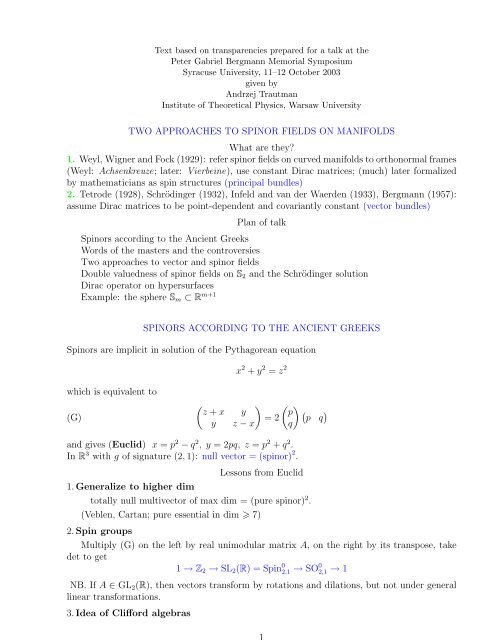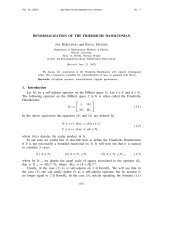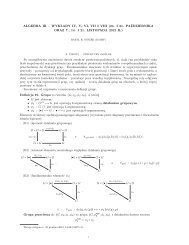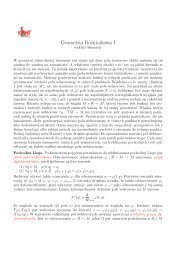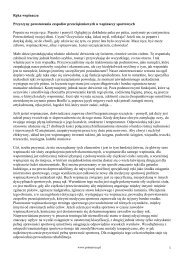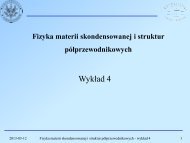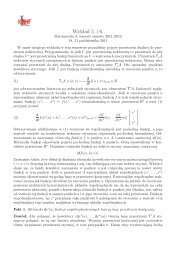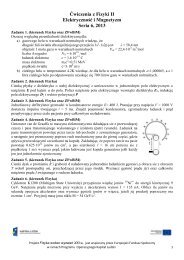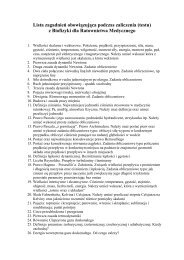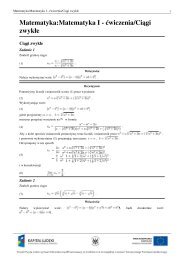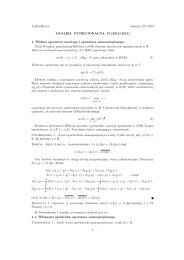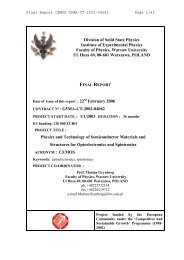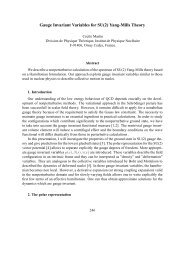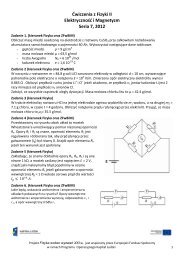TWO APPROACHES TO SPINOR FIELDS ON MANIFOLDS What ...
TWO APPROACHES TO SPINOR FIELDS ON MANIFOLDS What ...
TWO APPROACHES TO SPINOR FIELDS ON MANIFOLDS What ...
You also want an ePaper? Increase the reach of your titles
YUMPU automatically turns print PDFs into web optimized ePapers that Google loves.
Text based on transparencies prepared for a talk at the<br />
Peter Gabriel Bergmann Memorial Symposium<br />
Syracuse University, 11–12 October 2003<br />
given by<br />
Andrzej Trautman<br />
Institute of Theoretical Physics, Warsaw University<br />
<strong>TWO</strong> <strong>APPROACHES</strong> <strong>TO</strong> <strong>SPINOR</strong> <strong>FIELDS</strong> <strong>ON</strong> <strong>MANIFOLDS</strong><br />
<strong>What</strong> are they?<br />
1. Weyl, Wigner and Fock (1929): refer spinor fields on curved manifolds to orthonormal frames<br />
(Weyl: Achsenkreuze; later: Vierbeine), use constant Dirac matrices; (much) later formalized<br />
by mathematicians as spin structures (principal bundles)<br />
2. Tetrode (1928), Schrödinger (1932), Infeld and van der Waerden (1933), Bergmann (1957):<br />
assume Dirac matrices to be point-dependent and covariantly constant (vector bundles)<br />
Plan of talk<br />
Spinors according to the Ancient Greeks<br />
Words of the masters and the controversies<br />
Two approaches to vector and spinor fields<br />
Double valuedness of spinor fields on S2 and the Schrödinger solution<br />
Dirac operator on hypersurfaces<br />
Example: the sphere Sm ⊂ R m+1<br />
<strong>SPINOR</strong>S ACCORDING <strong>TO</strong> THE ANCIENT GREEKS<br />
Spinors are implicit in solution of the Pythagorean equation<br />
which is equivalent to<br />
(G)<br />
x 2 + y 2 = z 2<br />
<br />
z + x y p p <br />
= 2 q<br />
y z − x q<br />
and gives (Euclid) x = p 2 − q 2 , y = 2pq, z = p 2 + q 2 .<br />
In R 3 with g of signature (2, 1): null vector = (spinor) 2 .<br />
1. Generalize to higher dim<br />
Lessons from Euclid<br />
totally null multivector of max dim = (pure spinor) 2 .<br />
(Veblen, Cartan; pure essential in dim 7)<br />
2. Spin groups<br />
Multiply (G) on the left by real unimodular matrix A, on the right by its transpose, take<br />
det to get<br />
1 → Z2 → SL2(R) = Spin 0 2,1 → SO 0 2,1 → 1<br />
NB. If A ∈ GL2(R), then vectors transform by rotations and dilations, but not under general<br />
linear transformations.<br />
3. Idea of Clifford algebras
Multiply (G) by<br />
<br />
0<br />
−1<br />
<br />
1<br />
on the left, take square<br />
0<br />
<br />
y<br />
−z − x<br />
2 z − x<br />
= (x<br />
−y<br />
2 + y 2 − z 2 <br />
1<br />
)<br />
0<br />
<br />
0<br />
1<br />
“Quadratic form linearized”<br />
Replace z by iz to get complex spinors, Pauli matrices, Spin 3 = SU2, etc.<br />
4. Non-trivial topology involved<br />
Rotation by α in (p, q) plane:<br />
induces rotation by 2α in (x, y) plane:<br />
p ′ = p cos α + q sin α, q ′ = −p sin α + q cos α<br />
x ′ = x cos 2α + y sin 2α, y ′ = −x sin 2α + y cos 2α<br />
Take 0 α π to conclude: Spinors change sign when rotated by 2π<br />
WORDS OF THE MASTERS<br />
The relativity theory is based on nothing but the idea of invariance and develops from it<br />
the conception of tensors as a matter of necessity; and it is rather disconcerting to find that<br />
apparently something has slipped through the net, so that physical quantities exist,which it<br />
would be, to say the least, very artificial and inconvenient to express as tensors.<br />
C. G. Darwin, Proc. Roy. Soc. London A118 (1928) 654.<br />
The orthogonal transformations are the automorphisms of Euclidean vector space. Only with<br />
the spinors do we strike that level in the theory of its representations on which Euclid himself,<br />
flourishing ruler and compass, so deftly moves in the realm of geometric figures.<br />
.<br />
H. Weyl, The Classical Groups, Princeton U.P., 1946<br />
THE C<strong>ON</strong>TROVERSY<br />
E. Schrödinger mildly criticized the approach to spinor fields based on Weyl’s Achsenkreuze:<br />
Bei diesem Verfahren ist es ein bißchen schwer, zu erkennen, ob die Einsteinsche Idee des<br />
Fernparallelismus, auf die teilweise direkt Bezug genommen wird, wirklich hereinspielt oder ob<br />
man davon unabhängig ist.<br />
E. Schrödinger, Diracsches Elektron im Schwerefeld I, S. B. preuss. Akad. Wiss., 1932, 105–128.<br />
NB. Remarkable paper; contains the first derivation of formula for the square of the Dirac operator.<br />
Criticized by Cartan.<br />
Quotations from É. Cartan, The Theory of Spinors, English translation from the French published in<br />
1938.<br />
Footnote on p. 150:<br />
Certain physicists regard spinors as entities which are, in a sense, unaffected by the rotations<br />
which classical geometric entities (vectors, etc.) can undergo, and of which the components in a<br />
given reference system are susceptible of undergoing linear transformations which are in a sense<br />
autonomous. See for example L. Infeld and B. L. van der Waerden, “Die Wellengleichungen<br />
des Elektrons in der allgemeinen Relativitätstheorie”, S. B. preuss. Akad. Wiss., 1933, 380.<br />
Note that Cartan dismisses van der Waerden as a ‘certain physicist’
From p. 151:<br />
Theorem. With the geometric sense we have given to the word “spinor” it is impossible to<br />
introduce fields of spinors into the classical Riemannian technique; that is, having chosen an<br />
arbitrary system of co-ordinates x i for the space, it is impossible to represent a spinor by any<br />
finite number N whatsoever, of components uα such that the uα have covariant derivatives of<br />
the form<br />
uα,i = ∂uα/∂x i + Λ β<br />
αi uβ<br />
where the Λ β<br />
αi are determinate functions of xh .<br />
Cartan defines spinor fields by reference to orthonormal frames and emphasizes that mere curvilinear<br />
coordinates are not enough<br />
<strong>TWO</strong> <strong>APPROACHES</strong> <strong>TO</strong> VEC<strong>TO</strong>R AND <strong>SPINOR</strong> <strong>FIELDS</strong><br />
Recall two ways of describing vector fields on m-dim manifold:<br />
1. start from principal bundle P of linear frames<br />
GLm(R) −−−→ P<br />
⏐<br />
<br />
M<br />
X<br />
−−−→ R m<br />
vector field X is equivariant map: X(ea) = a −1 X(e), a ∈ GLm(R), e ∈ P . If s : M → P is a<br />
section, then X ◦ s : M → R m gives the components of X with respect to the field of frames s.<br />
2. tangent bundle<br />
vector field X ′ is section of the tangent bundle<br />
1⇒ 2 by forming associated bundle:<br />
1⇐ 2 define<br />
π<br />
T M<br />
⏐ <br />
⏐<br />
<br />
M<br />
⏐<br />
⏐X ′<br />
Connection between the two:<br />
(P × R m )/ GLm(R) = T M<br />
P = {e : R m → TxM linear isom. | x ∈ M}<br />
Consider analogous definitions for spinors. For simplicity of notation assume (M, g) to be<br />
proper Riemannian, orientable manifold. Recall that given a quadratic space (V, h), one has<br />
the Clifford algebra Cl(V, h) and the spin group Spin(V, h) ⊂ Cl(V, h); if V = R m and h definite,<br />
then write Clm, Spin m, SOm, etc. A representation γ : Clm → End S defines by restriction a<br />
representation<br />
γ : Spin m → GL(S)<br />
in the vector space S of spinors
1. start from principal spin bundle Q, a reduction of the bundle of orthonormal frames P on<br />
M,<br />
Spinm −−−→ Q<br />
⏐ ⏐<br />
⏐ ⏐<br />
<br />
SOm −−−→ P ⏐⏐<br />
spinor field Ψ of type γ is equivariant map:<br />
M<br />
Ψ<br />
−−−→ S<br />
Ψ(qa) = γ(a −1 )Ψ(q), a ∈ Spin m .<br />
The Levi-Civita connection lifts from P to Q and defines Dirac operator γ µ ∇µ acting on spinor<br />
fields Ψ : Q → S. No teleparallelism required.<br />
2. To define bundle of spinors Σ → M, analogous to T M → M, consider the Clifford bundle<br />
Cl(g) = <br />
x∈M Cl(TxM, gx) → M<br />
and a map of bundles<br />
such that for x ∈ M, the restriction<br />
γ : Cl(g) → End Σ<br />
γx : Cl(TxM, gx) → End Σx<br />
is a representation of the Clifford algebra Cl(TxM, gx) in Σx. Sections Ψ : M → Σ are spinor<br />
fields.<br />
NB. Schrödinger assumed γx to be the Dirac repr., whereas Bergmann considered 2-component<br />
0 τ<br />
Weyl spinors and split Σ = Σ+ ⊕ Σ− so that γ = .<br />
σ 0<br />
If X : M → T M → Cl(g) is a vector field, then γ(X) : M → End Σ is a field of matrices acting<br />
on spinor fields. Covariant differentiation is introduced by requiring<br />
∇X(γ(Y )Ψ) = γ(∇ LC<br />
X Y )Ψ + γ(Y )∇XΨ<br />
1⇒2 is by forming the associated bundle<br />
Going from 2 to 1 is somewhat subtle, especially in the non-orientable, odd-dim case; see Th.<br />
Friedrich and A. Trautman, Ann. Global Anal. Geom. 18 (2000) 221–240.<br />
DOUBLE VALUEDNESS OF <strong>SPINOR</strong> <strong>FIELDS</strong> <strong>ON</strong> S2 AND THE SCHRÖDINGER TRICK<br />
As example, construct spin structure on M = S2; note first Spin 2 = U1. The spin bundle is<br />
Q = Spin 3 = SU2 = S3 = {q = (q1, q2) ∈ C 2 : |q1| 2 + |q2| 2 = 1},<br />
the action of Spin 2 on Q is (q, a) ↦→ qa = (q1a, q2a), a ∈ U1, and the bundle of orth. frames<br />
P = SO3 = SU2 /Z2 so that<br />
Q → P is (q1, q2) ↦→ ±(q1, q2) and
Q → S2 is (q1, q2) ↦→ (2q1¯q2 = x + iy, |q1| 2 − |q2| 2 = z)<br />
Consider Euler angles (θ, ϕ, χ) on Q = S3; they define local coords so that<br />
and Q → S2 is (q1, q2) ↦→ (e iϕ sin θ, cos θ).<br />
q1 = e 1<br />
2 i(χ+ϕ) cos 1<br />
2 θ, q2 = e 1<br />
2 i(χ−ϕ) sin 1<br />
2 θ<br />
The ‘usual’ field of orth. frames (dθ, sin θ dϕ) is def on the 2-sphere S • 2 with the two poles<br />
(θ = 0 and π) removed; it corresponds to the section χ = 0, i.e. to<br />
(θ, ϕ) ↦→ ± (e 1<br />
2 iϕ cos 1<br />
2<br />
Note map well defined at ϕ = 0 ≡ 2π because of ± .<br />
θ, e− 1<br />
2 iϕ sin 1<br />
2 θ)<br />
But it does not lift to a map from S • 2 to S3: for this, a meridian, such as ϕ = 0, has to<br />
be removed. If this is not done, then spinor fields on S2 become double-valued. Indeed, the<br />
Dirac repr. γ : Spin 2 = U1 → GL2(C) is faithful so that γ(−1) = −I; a Dirac spinor field<br />
Ψ : Q = S3 → S = C 2 satisfies Ψ(qa) = γ(a −1 )Ψ(q) so that Ψ(−q) = −Ψ(q).<br />
Take section s : S • 2 {ϕ = 0} → S3<br />
s(θ, ϕ) = (e 1<br />
2 iϕ cos 1<br />
2<br />
θ, e− 1<br />
2 iϕ sin 1<br />
2 θ)<br />
then limϕ→0 s = − limϕ→2π s. Look at the ‘usual’ description of spinor field: Ψ ◦ s.<br />
This and similar problems were noticed, considered at length, and solved by the masters:<br />
E. Schrödinger, Eigenschwingungen des sphärischen Raums, Comment. Pontificia Acad. Scientiarum<br />
2 (1938) 321–364.<br />
E. Schrödinger, Die Mehrdeutigkeit der Wellenfunktion, Helv. Phys. Acta 32 (1938) 49–55.<br />
W. Pauli, Über ein Kriterium für Ein- oder Zweiwertigkeit der Eigenfunktionen in der Wellenmechanik,<br />
Helv. Phys. Acta 12 (1939) 147–168.<br />
Note: double valuedness does not arise if one starts from a field of orth. frames on S2<br />
coming from the stereographic projection; there is then the section<br />
s ′ : S2 {θ = 0} → S3, s ′ (θ, ϕ) = (eiϕ cos 1 1 θ, sin 2 2θ) and Ψ ◦ s′ is single-valued. This approach<br />
taken in theory of spin spherical harmonics.<br />
Schrödinger’s solution of the problem:<br />
note that the Dirac representation of Spin 2n in 2 n -dim space of spinors extends to the Pauli<br />
representation of Spin 2n+1 in the same space (“add γ5”); in particular<br />
γ<br />
Spin2 −−−→ GL2(C)<br />
⏐<br />
<br />
⏐<br />
<br />
inj<br />
<br />
Spin 3 −−−→<br />
σ<br />
GL2(C)<br />
Consider the spinor field (equivariant map) Ψ : Spin 3 → C 2 . Form Φ(q) = σ(q)Ψ(q), then for<br />
a ∈ Spin 2 one has Φ(qa) = Φ(q) so that Φ descends to a globally defined, single-valued map<br />
ψ : S2 → C 2 . This shows: bundle Σ of spinors on S2 is trivial. But the tangent bundle is not.
Generalize: Theorem. Every hypersurface M immersed in R m+1 has a (s)pin structure and<br />
the bundle of Dirac (m even) or Pauli (m odd) spinors, associated with it, is trivial.<br />
If m even and M orientable, then there is the bundle of Weyl (chiral) spinors over M; it need<br />
not be trivial.<br />
The Dirac operator, originally defined to act on the equivariant map Ψ : Q → S, for a<br />
hypersurface M descends to act on the corresponding field ψ : M → S.<br />
DIRAC OPERA<strong>TO</strong>R <strong>ON</strong> HYPERSURFACES<br />
Assume M to be an even-dimensional orientable hypersurface in R m+1 and let n µ , µ = 1, . . . , m+<br />
1, be a field of unit normals on it. Let γµ be the Dirac matrices satisfying<br />
and put N = γµn µ ,<br />
γµγν + γνγµ = −2δµνI<br />
σµν = 1<br />
4 (γµγν − γνγµ) and Lµν = nν∂µ − nµ∂ν.<br />
The vector fields Lµν are tangent to M. One derives the following formula for the Dirac operator<br />
acting on ψ : M → S:<br />
D = N(σ µν Lµν − 1div<br />
n) 2<br />
and<br />
DN + ND = 0<br />
so that N plays the role of γ5 in SRT. (Analogy with Polyakov’s hedgehog solution.)<br />
There is more if there is a foliation of R m+1 by hypersurfaces; introducing ∂<br />
∂r = nµ ∂µ one<br />
has the decomposition<br />
γ µ ∂µ = D + N( ∂<br />
∂r<br />
1 + div n) 2<br />
EXAMPLE: THE SPHERE Sm ⊂ R m+1<br />
Consider R m+1 foliated by spheres r = const., then n µ = x µ /r and div n = m/r; for m = 3<br />
the vector with components rL23, rL31, rL12 is the angular momentum operator.<br />
Recall formula for the Laplacian:<br />
∆Rm+1 = r −2 −m ∂ ∂<br />
∆Sm + r rm<br />
∂r ∂r<br />
Evaluating on a harmonic polynomial homogeneous of degree l gives the eigenvalues −l(l+m−1)<br />
of ∆Sm.<br />
An analogous formula for the Dirac operator is<br />
γ µ ∂µ = r −1 −m/2 ∂<br />
DSm + Nr ∂r rm/2<br />
Take now for φ : R m+1 → S a harmonic, homogeneous of degree l + 1, S-valued polynomial,<br />
then ψ = γ µ ∂µφ is of degree l and satisfies γ µ ∂µψ = 0, therefore<br />
DSmψ = −(l + 1<br />
2 m)ψ and DSmNψ = (l + 1<br />
2 m)Nψ<br />
so that the spectrum of the Dirac operator on Sm is the set ±(l + 1<br />
2 m), l = 0, 1, . . ..<br />
The author’s paper “The Dirac operator on hypersurfaces” Acta Phys. Polon. B 26, 1283–1310<br />
(1995) contains further information and references.


